This article talks about app store optimization mistakes and how you can avoid them.
Have you optimized your mobile app listing for better discoverability in an app store?
Does your app rank on the top of search result page in an app store?
Do people download your app?
If not, then chances are you are making common app store optimization mistakes.
As of March 2017, around 2.8 million apps were available for Android users, and Apple’s App Store was having 2.2 million apps according to Statista.
So, if you do not do app store optimization properly, it will affect the discoverability of your app in an app store.
In today’s post, I am going to discuss the top 11 app store optimization mistakes.
After reading this post, you will know how to do app store optimization right way to get a higher ranking.
Without further ado, let us dive in:
1- Not Knowing Customers
Many businesses make this app store optimization mistake. Without knowing their customers well, they launch their apps and desire high rankings in an app store. You must avoid this mistake.
Before listing your app on an app store, you should know the answers to the following questions:
- What language your potential customers naturally speak
- What problems your app solves
- Which competitive advantage you have
- Which keywords your competitors target
The point here is,
You should put yourself in your customer’s shoes. This will help you know the language and tone of voice you should use to list your app in an app store.
If you know your customers well, you can easily write an engaging description for your app.
Facebook has done the same for its Facebook Lite app on Play Store.
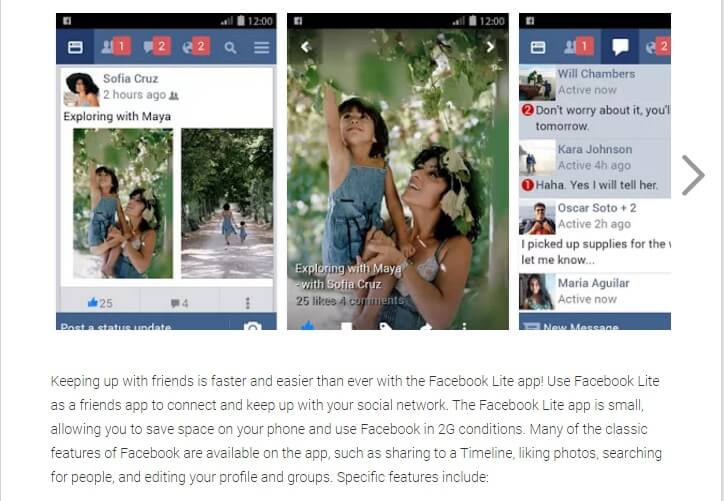
2- Failing to Choose a Right App Name
Yes, my friend, the name of your app matters a lot. Do not make this app store optimization mistake by not choosing a right name for your app.
Our friends at TUNE conducted a study and found that apps with relevant keywords in their titles ranked 10.3% higher than the apps without keywords in titles.
However, it is not always easy to include a keyword in the title of an app. If it is so, you should go for a short and sweet name.
Here are a few tips on choosing a right name for your app:
- Choose an easy-to-remember app name
- Never choose a name similar to any other popular app
- Choose a name that aligns with the branding of your business
- Pick an intuitive name for your app
Instagram is a perfect name for an app. It is short, simple, and easy-to-remember.
What’s more, it is intuitive. Instagram = Instant + Telegram

3- Missing Keywords
Apple’s App Store and Google Play Store follow different approaches when it comes to ASO keywords.
iTunes Connect Keyword Field has a limit of 100 characters total, with words separated by a comma. You should maximize the number of words that fit in this character limit. Here are some tips:
- Avoid using the plurals of words you have already used once
- Don’t use the word ‘app’
- Avoid using duplicate words
Google Play Store is quite different when it comes to adding keywords.
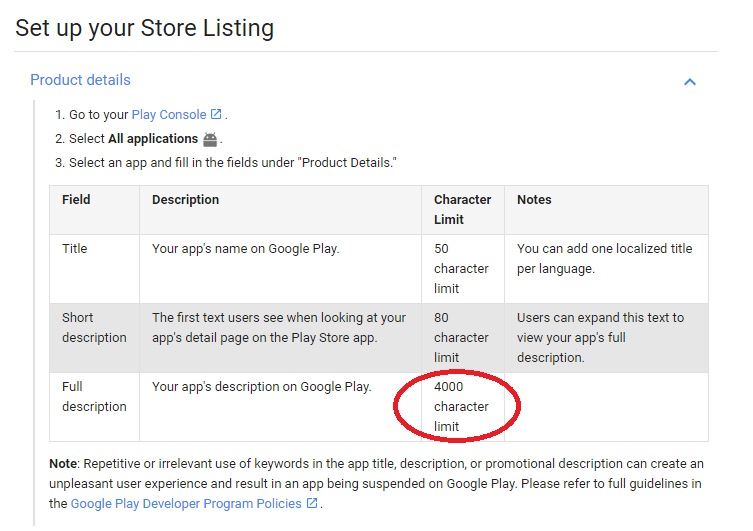
Unlike Apple’s App Store, Google Play Store gives you 4000 characters to describe your app. You should naturally sprinkle keywords or key phrases when you write a full description of your application.
According to a study conducted by SensorTower,
“Using your target keyword five times in the description of your app will give it the best chance of ranking for that keyword.”
As ranking algorithms consider both keywords and conversion metrics, you should write for customers first and make small tweaking for keywords.
Remember, my friend, Keyword strategy for any app depends on the place where you are going to list it.
4- Not Having a Unique Icon
If you want your app to stand out from the crowd, you should have a unique icon for your app.
Both Apple’s App Store and Google Play Store have different guidelines for app icons.
Here is the size of icon that Apple’s App Store recommends:
![]()
Icon of your app must embrace simplicity, offer a single focus point, and keep simple background.
On the other hand, Google Play requires icon size 512px by 512px.
![]()
Whether it is Apple’s App Store or Google’s Play Store, you need to have an icon that is able to stand out from the crowd.
You should never complicate the icon of your app with words.
5- Boring App Description
A boring app description is a common app store optimization mistake.
App description plays a very important role in higher ranking in an app store.
How should you write the description for your app?
Your description should target the customer base of your app. However, you should not forget strategically using relevant keywords in the description.
Be it Google Play Store or Apple’s App Store, app descriptions work as call-to-action buttons. So, you should make sure that the app description should convey clearly the benefits it offers. Only then, people will feel compelled to download it.
The first 3-4 lines matter a lot. Make sure you write the beginning of the introduction catchy enough to hold the attention of visitors.
If you update your app, you should edit the description to reflect the update.
Here is how Candy Crush Saga has made the introduction of the description catchy for Apple’s App Store.
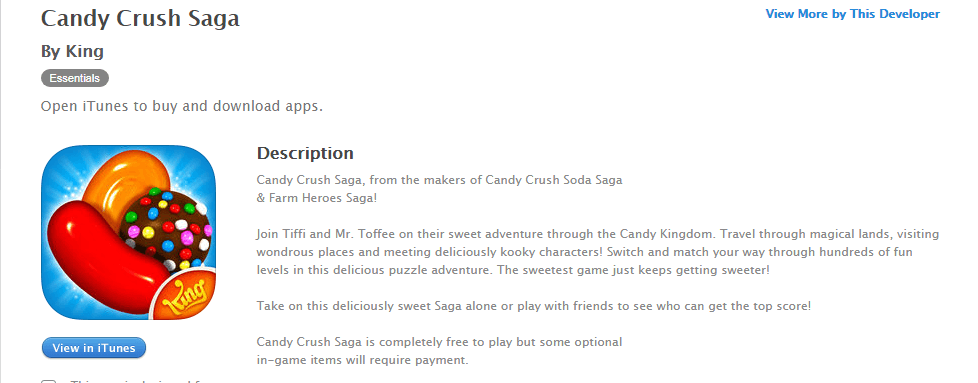
6- Not Using Screenshots
You must avoid this app store optimization mistake.
Like icons, screenshots & videos do not play a direct role in the ranking of your app in an app store. But awesome screenshots encourage people to download your app. The more downloads your app has, the better it will have a ranking in app store eventually.
Though you can upload up to 8 screenshots for an Android app and up to 5 screenshots for an iOS, only 2-3 screenshots will appear in page load or the gallery.
You should make sure that these screen shots are good enough to convey the benefits of your app.
It is advisable that you should do A/B testing to find out the most effective screenshots for your app.
Here is how Temple Run has used its screenshots in Apple’s App Store.
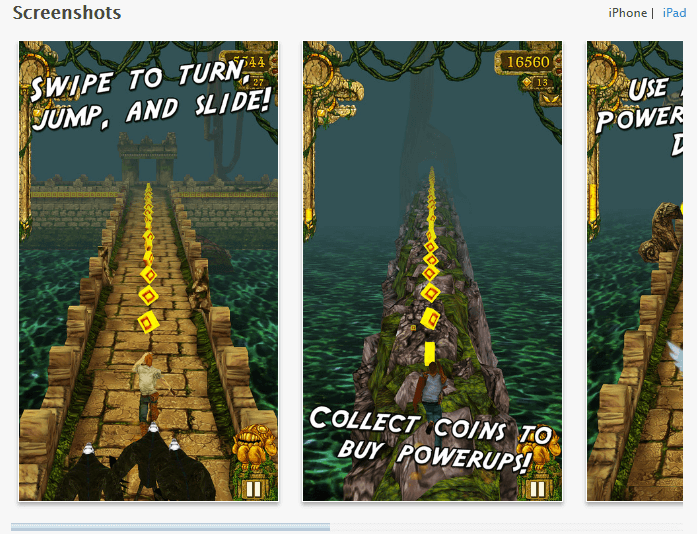
7- Failing to Encourage Ratings & reviews
The more positive reviews and rating you app has, the better ranking it will get in an app store.
Rating and reviews are one of the highest determinants of rank in app stores.
You can use intelligent rating/review prompt to increase the rating/reviews of your app.
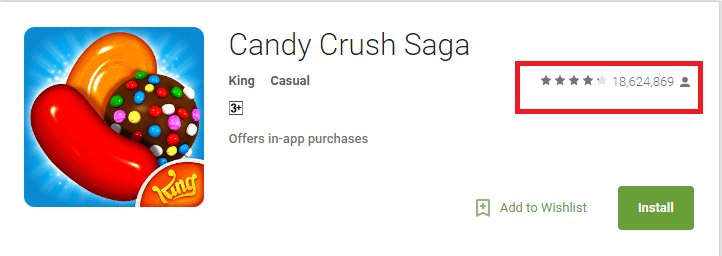
8- Not Promoting Downloads
You have created an awesome app, and you have uploaded high-quality screenshots. Do you think that people will download your app like anything?
My friend, they will not download your app unless you push them a bit.
How can you promote downloading of your app?
Here are a few tips:
- You should use search networks to promote downloads
- Employ display networks to create awareness that will promote downloads
- Never forget the power of social media when it comes to promoting downloads
Remember, all the successful apps needed an initial push. You should plan an effective app promotion marketing strategy.
9- Not Updating Frequently
Mobile app users are always in the search of apps that are frequently updated based on customers’ feedback. Still, people commit this app store optimization mistake.
If you do not update your app frequently, people will think that you do not care for the app. On the other hand, frequently updated apps garner more positive reviews and rating.
What should be the update frequency?
Ideally, you should update your app between 30-40 days.
Also, you should encourage people to download updates as well.
Having a good number of five-star reviews is helpful in convincing people to download your app updates as people check reviews and rating before downloading any app update.
10- Not localizing App Listing
When it comes to mobile app marketing, you must consider localizing app listing.
A good thing is,
Both the Google Play Store and Apple’s App Store allow businessmen to localize their listings so as to offer easy readability and discoverability for customers in different countries.
For example, if you want to target the Chinese audience, you should think about localizing listing in the Chinese language. This will boost both the adoption and conversion.
11- Ignoring Outside Traffic and Promotion
This is a very common app store optimization mistake. Businesses completely ignore outside traffic and promotion.
If you want to make your app popular, you should never ignore outside traffic and promotion.
It is quite simple. The more traffic your app listing has, the better it will rank in search results. So, you should try to find ways to drive traffic to your app listing, whether it is on Google Play Store or Apple’s App Store.
Building a strong online presence around your app through content, social media, press, reviews, and paid marketing can drive traffic to your app listing.
This is where your SEO knowledge plays a deciding role. Follow the best SEO practices to drive traffic to your app listing.
Conclusion:
Regardless of your niche, there is a fierce competition to rank higher on an app store. You must avoid these common app store optimization mistakes if you want your app to have a higher ranking.
Do you want to draw our attention to any other app store optimization mistake? Do share it in the comment section. I would love to hear about it.

